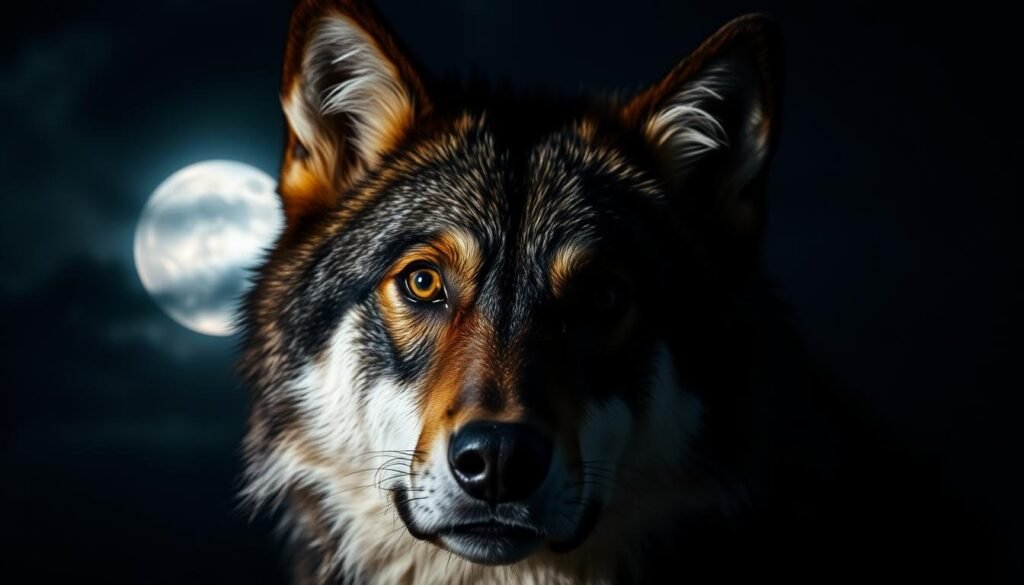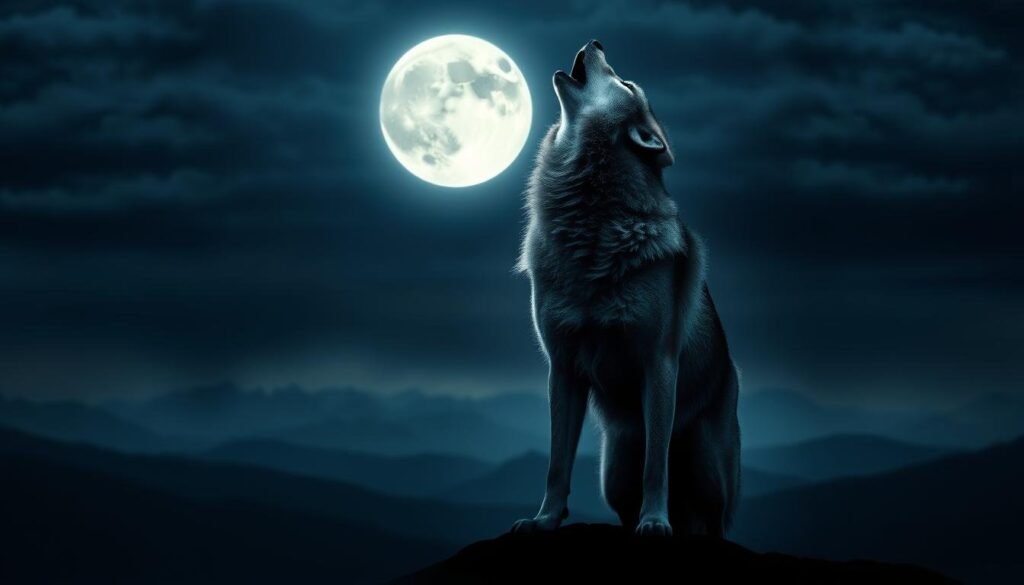Why Do Wolves Howl at the Moon? You’ve likely heard the haunting sound of wolf howling echoing through the night, often associated with the moon. But have you ever wondered what’s behind this behavior?
The idea that wolves howl at the moon is a common trope in popular culture. But is it based in reality? The relationship between wolf howling and the moon is more complex than you might think.
In this article, we’ll explore the fascinating reasons behind wolf howling and its connection to the moon. We’ll dispel common misconceptions and shed light on the science behind this iconic behavior.
Contents
- 1 The Myth vs. Reality of Wolf Howling
- 2 Why Do Wolves Howl at the Moon? The Scientific Explanation
- 3 Different Types of Wolf Howls and Their Meanings
- 4 How Wolf Howling Differs From Other Canine Vocalizations
- 5 Cultural Significance of Wolf Howling Throughout History
- 6 Understanding Wolf Howling: A Complex Behavior
- 7 FAQ: Why Do Wolves Howl at the Moon?
- 7.1 Why do wolves howl at the moon?
- 7.2 What is the purpose of wolf howling?
- 7.3 Are there different types of wolf howls?
- 7.4 How does wolf howling differ from other canine vocalizations?
- 7.5 What is the cultural significance of wolf howling?
- 7.6 Do wolves howl more during a full moon?
- 7.7 Can wolves howl to locate their pack members?
The Myth vs. Reality of Wolf Howling
Wolves and the moon have been linked for centuries. But, the truth about their howling is more complex. The idea that wolves howl at the moon is a common myth. It’s found in stories, books, and movies, but it’s mostly not true.
Canine behavior experts have shown that wolves howl for many reasons. They don’t do it because of the moon. Wolves howl to find their pack, to warn others, or to show feelings like anxiety or excitement.
| Myth | Reality |
|---|---|
| Wolves howl at the moon. | Wolves howl to communicate with other pack members or to signal their location. |
| The full moon triggers howling. | Howling is not directly related to the lunar cycle; it’s about animal communication. |
Knowing the truth about wolf howling helps us appreciate these animals more. By studying canine behavior and animal communication, we learn about wolf pack dynamics. It’s fascinating to see how wolves interact with each other.
Why Do Wolves Howl at the Moon? The Scientific Explanation
Wolves howling at the moon is a fascinating topic. It’s all about how they communicate. This behavior is key to their social lives.
Understanding Wolf Communication
Wolf howling has many uses. It helps them find each other, warn of dangers, and show their social bonds. Each howl can mean something different.
When and where wolves howl matters too. They often howl at dawn and dusk. The full moon might make them howl more, but it’s not the only reason.
| Context | Purpose of Howling | Frequency |
|---|---|---|
| Locating pack members | To reunite or locate the pack | High |
| Warning of threats | To alert pack members of potential danger | Moderate |
| Social behavior | To strengthen social bonds within the pack | Variable |
Studying wolf howling helps us understand their social lives. It’s not just about the moon. It’s a complex language for survival and social ties.
In summary, wolf howling is a vital way for them to communicate. By learning about it, we can see the depth of their social and survival strategies.
Different Types of Wolf Howls and Their Meanings
Wolf howls are not just sounds; they have different meanings. Wolves use different voices to send messages. This helps us understand their complex social lives.
Wolf howls can be grouped into several types. Each type has its own sound and purpose. These include:
- Locational howls: Used to locate other pack members.
- Assembly howls: Serve as a call to gather the pack.
- Alarm howls: Indicate potential threats or danger.
- Social howls: Help maintain social bonds within the pack.
Each howl type is important for animal communication. For example, a locational howl helps a lost wolf find its pack. An alarm howl warns others of danger.
Learning about these howls helps us appreciate canine behavior more. By studying wolf sounds, researchers learn about their social lives and behaviors.
In conclusion, wolf howls are a key part of their communication. Recognizing and understanding these sounds helps us see the complex social lives of wolf packs.
How Wolf Howling Differs From Other Canine Vocalizations
Wolf howls are quite different from the barks and whines of other dogs. Domestic dogs bark to alert their owners or whine to get attention. But wolves use howling as a main way to talk over long distances. This special sound is key for their survival in the wild.
Here are some key differences between wolf howling and other canine vocalizations:
- Purpose: Wolf howls help locate pack members, warn others to stay away, or strengthen bonds.
- Frequency and Pitch: Wolf howls are lower in pitch and more steady in frequency than other dogs’ barks or yips.
- Context: Wolves howl at night to find their pack or when they hear sirens or other howls.

Understanding these differences helps us see how wolves are different from other dogs. By studying wolf howling, scientists learn more about their social lives, where they live, and how they behave.
In conclusion, wolf howling is a unique part of their behavior. It’s a crucial way they communicate and survive in their social world.
Cultural Significance of Wolf Howling Throughout History
The image of wolves howling at the moon is rich in history. It comes from myths, folklore, and pop culture. This image shows how humans have both admired and feared wolves.
In ancient times, wolves were seen as strong and skilled hunters. Their howls at the moon were often linked to the divine. For example, in Native American cultures, wolves are sacred, symbolizing guidance and determination.
Human folklore about wolves is complex. In European tales, wolves are seen as omens of darkness and fear. Yet, they are also known for their loyalty and family ties, as in the story of Romulus and Remus, Rome’s founders, who were raised by a she-wolf.
In modern culture, wolves howling at the moon symbolize freedom and wildness. This is seen in books, movies, and art. The howling wolf stands for human emotions and experiences.
| Culture | Symbolism of Wolf Howling |
|---|---|
| Native American | Guidance, Perseverance |
| European | Omen, Darkness, Fear |
| Roman | Nurturing, Protection |
The cultural meaning of wolves howling at the moon is deep and varied. It reflects many human feelings and experiences. As we remain captivated by wolves, their symbolism in our culture will likely continue to grow.
Understanding Wolf Howling: A Complex Behavior
Now you know why wolves howl at the moon. It’s not just about the moon. It’s a way for them to communicate, bond, mark territory, and express emotions.
Science shows that wolf howling is key to their behavior. It’s shaped by their pack and the environment. Different howls mean different things, unlike other dogs.
Wolf howling has always been fascinating to humans. It shows our mix of awe, fear, and respect for wolves. Learning about wolf howling helps us understand these amazing animals better. It also reminds us of the need to protect their place in nature.
See Also: Why Do Squirrels Gather and Bury Nuts?
FAQ: Why Do Wolves Howl at the Moon?
Why do wolves howl at the moon?
Wolves don’t actually howl at the moon. They howl to communicate, find other wolves, or warn of dangers. It’s a way to show social behavior.
What is the purpose of wolf howling?
Wolf howling has many purposes. It helps them find other wolves, warn of dangers, and show social behavior. It’s a complex way of talking that keeps wolf packs together.
Are there different types of wolf howls?
Yes, there are many types of wolf howls. Each one means something different. Researchers have found various sounds wolves make, each with its own message.
How does wolf howling differ from other canine vocalizations?
Wolf howling is unique compared to other dog sounds like barking or whining. Its special qualities meet wolves’ specific needs, making it stand out.
What is the cultural significance of wolf howling?
Wolf howling has a big place in myths, folklore, and movies. It often shows both wonder and fear. The idea of wolves howling at the moon has been used in many cultures and times.
Do wolves howl more during a full moon?
No, research shows wolves don’t howl more during a full moon. The idea that they do is a myth that science has proven wrong.
Can wolves howl to locate their pack members?
Yes, wolves use howling to find their pack. It helps them stay in touch, especially when they’re far apart.

Zyair Larson, based in Denver, Colorado, has over 12 years of experience studying animal behavior. He has worked with the World Wildlife Fund (WWF) and National Geographic, researching wildlife and sharing insights on animal habits globally.

